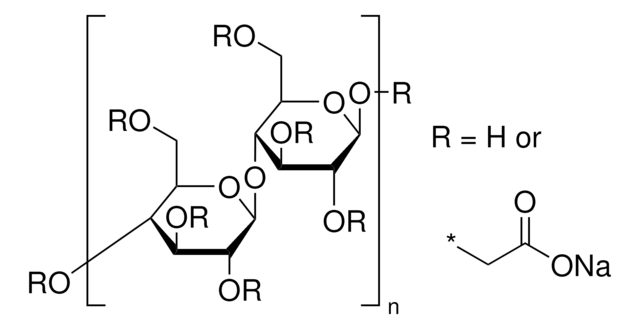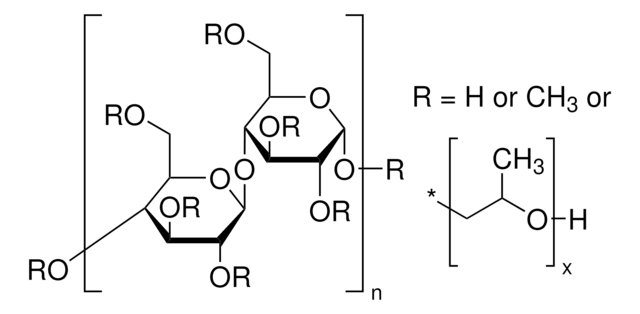C4888
Carboxyméthylcellulose sodium salt
Medium viscosity
Synonyme(s) :
Carboxyméthylcellulose de sodium
About This Item
Produits recommandés
Source biologique
wood (pulp)
Niveau de qualité
Forme
powder
Couleur
light yellow
Plage de pH utile
(20 °C, 10 g/L, 68 °F neutral)
Viscosité
400-800 cP, 2 % in H2O(25 °C)(lit.)
Pf
> 300.05 °C ((> 572.09 °F))
Solubilité
water: soluble
Traces de cations
Na: 6.5-9.5%
Température de stockage
room temp
InChI
1S/C6H12O6.C2H4O2.Na/c7-1-3(9)5(11)6(12)4(10)2-8;1-2(3)4;/h1,3-6,8-12H,2H2;1H3,(H,3,4);
Clé InChI
DPXJVFZANSGRMM-UHFFFAOYSA-N
Vous recherchez des produits similaires ? Visite Guide de comparaison des produits
Description générale
Low, medium and high viscosity CMCs are all used as suspending agents. Low viscosity CMC is usually used in "thin" aqueous solutions. Medium viscosity CMC is used to make solutions that look like a syrup. High viscosity CMC is used to make a mixture, which resembles a cream or lotion.
Application
Notes préparatoires
The key to dissolving carboxymethylcellulose is to add the solid carefully to the water so that it is well dispersed (well-wetted). Adding the solid in portions may be necessary. Adding water to the dry solid produces a "clump" of solid that is very difficult to dissolve; the solid must be added to the water. Stir gently or shake intermittently; do not stir constantly with a magnetic stirring bar. High heat is not needed and may actually slow down the solubilization process. A mixing device, such as an impeller-type agitator which produces a vortex, would allow the powder to be drawn into the liquid, but it may produce some shearing.
Autres remarques
Code de la classe de stockage
11 - Combustible Solids
Classe de danger pour l'eau (WGK)
WGK 1
Point d'éclair (°F)
Not applicable
Point d'éclair (°C)
Not applicable
Équipement de protection individuelle
Eyeshields, Gloves, type N95 (US)
Certificats d'analyse (COA)
Recherchez un Certificats d'analyse (COA) en saisissant le numéro de lot du produit. Les numéros de lot figurent sur l'étiquette du produit après les mots "Lot" ou "Batch".
Déjà en possession de ce produit ?
Retrouvez la documentation relative aux produits que vous avez récemment achetés dans la Bibliothèque de documents.
Les clients ont également consulté
Notre équipe de scientifiques dispose d'une expérience dans tous les secteurs de la recherche, notamment en sciences de la vie, science des matériaux, synthèse chimique, chromatographie, analyse et dans de nombreux autres domaines..
Contacter notre Service technique





